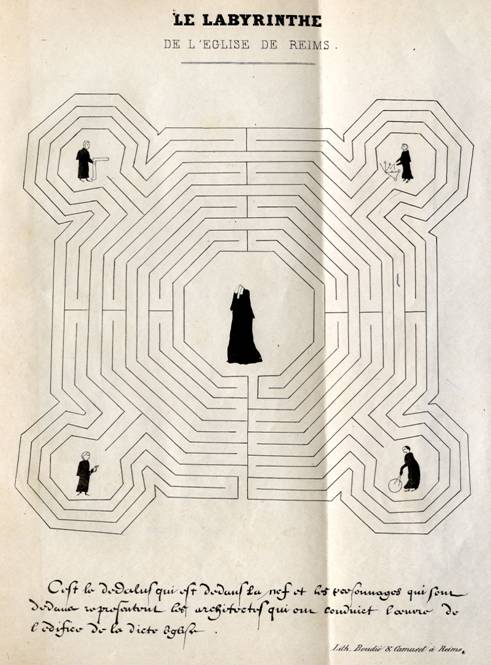The Easter Dance of the Cathedrals
Yes, they really did. They didn’t just say that heaven’s a dance, or the liturgy’s a dance, or our relationship with God is a dance. They danced. Led by the bishop, and often playing a ball game at the same time.
Until the early 16th century, there was an Easter dance in many of the French cathedrals. It was a farandole, a circle dance in triple time, to the accompaniment of the Victimae Paschali Laudes (“Praise to the Paschal Victim”), the triumphant chant of the Resurrection. If the cathedral had a labyrinth (such as at Chartres or Amiens), the dance would take place around it.
A bizarre medieval ritual? A pagan hangover? A safe way for clergy to let off steam? Until recently it was assumed that the dance was indeed a pagan ritual which had been semi-Christianised – and for the same reason was swept away by the reforms of the 16th century. But working as I do in dance, directing the Cosmos project www.cosmosdance.com , I decided to research the Easter dance and found that in fact it goes back to forgotten Jewish and Christian mystical traditions.
Philo of Alexandria, a Jewish philosopher who was a contemporary of Jesus, knew a double monastic community of men and women called the Therapeutes, which means both “healers” and “praisers”. They came together to chant in their sanctuary and danced in what seems to have been circle dances. Their inspiration was the men’s and women’s songs and dances led by Moses (Exodus 15.1-18) and Miriam (15.20-21) after the miraculous crossing of the Red Sea.
Eusebius, the 4th-century church historian, thought that the Therapeutes were Christians. This is very unlikely, but the fact that he thought it suggests that for Eusebius, as a Christian, praising God through dance was not a strange idea. In fact, the early Christians knew a mystical tradition that Christ, the Logos (Word) of God is leader of the angelic dance.
St. Gregory of Nyssa, from the generation after Eusebius, tells of how, when the world was first created, Adam and Eve danced with the angels. At the Fall, Adam and Eve were tripped up by sin and fell out of the dance, becaming estranged from the angels. But by his Cross and Resurrection, Christ has restored us to the dance.
Why should the angels dance, though? The Bible sometimes speaks of angels as stars, perhaps because the angels watch over the earth and shed God’s light on it. God tells Job that “the morning stars sang together” at the Creation of the world (Job 38.7). In Revelation or the Apocalypse, the seven stars are the angels of the Seven Churches (1.20), and there is Wormwood, the fallen angel/star (8.11). The stars are seen to move around the sky, and with the benefit of modern astronomy, we know that the planets move in an orbit, as if they were circle dancing.
The Church Fathers are perhaps better known for preaching against dancing. But what they were attacking was the kind of orgiastic, alcohol-fuelled dancing which went on sometimes at parties, and could have exactly the same consequences as that office Christmas party or ‘lost weekend’. St. Basil, a contemporary of Gregory’s, is no exception – he condemned lewd dancing at Easter. But he encouraged the spiritual dance, saying that a place in the dance of the angels was a gift of the Holy Spirit: it came with “understanding of mysteries, apprehension of hidden things”, and even “becoming God”: a profound and total union with the Trinity.
By the end of the Middle Ages, people had forgotten the amazing significance of the Easter dance, and perhaps as a result it fell into bad behaviour: little by little the cathedrals suppressed it (though it survives in a different form in Seville and Cordoba).
But times have changed. Today many contemporary dancers see dance as something profoundly and essentially spiritual, and many people who say they are spiritual but not religious practise dance.
Why? St. Thomas Aquinas, the great medieval philosopher and theologian, said that all knowledge comes to us through our senses. Just like dancing: you can only really dance if you’re absolutely present to what you’re doing, and then we perceive all the things we miss, when we’re distracted. Dance is a space where God speaks to us through our senses.
Or is that all theory?
At the recent Recreation conference at The Holy Biscuit Christian arts hub in Newcastle-upon-Tyne www.theholybiscuit.org/, we put the Easter dance to the test. To the original music, and the original step, we circle danced in the garden (watched by our bemused neighbours). The step required both a kick up and landing with both feet on the ground. As you go up, you see the stars. As you come down, you feel the earth. And everyone is united, in a circle: a great way of praying “on earth as it is in heaven”. But the best bit for me was the ball. It probably represented the world, dancing because it had been recreated from chaos into cosmos by Christ, the risen Logos, who “ascended far above all the heavens, that he might fill all things” (Ephesians 4.10).
There were moments when the ball got dropped. But it wasn’t a disaster. Someone picked it up, we all laughed, and rejoined the dance. Perhaps, with the perspective of eternity, that’s how the Fall looks to the angels of God. “O happy fault”, we sing in the Exultet, the great hymn of cosmic praise at the Easter vigil. Adam and Eve fell, but Christ came and raised them up, higher than they had been before. The dance teaches us not be dragged down by sin and suffering. Instead, let’s follow the dancing ball of the New Creation, rejoice that Christ has remade us, dancing us to union with God.
This article was written for the Bard school blog by our priest Fr Dominic White ,OP
The picture of the octagonal labyrinth of Reims, can be found can find on the website Revista Transcultural de Musica – where there is a fascinating article by Michael Eisenberg which dicusses Performing the Passion, Music, Ritual and the Eastertide Labyrinth – by Micheal Eisenberg)


